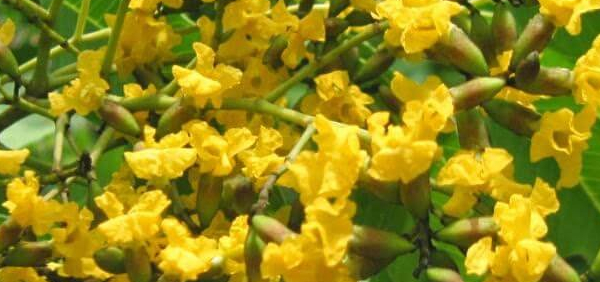tavakshiri :

Morphology:
Curcuma angustifolia is rhizomatous herb. It is a perennial and a flowering plant, with modest and small spiked inflorescences of three or four yellow, funnel-shaped flowers within tufts of pink terminal bracts (coma bracts). The bracts are boat-shaped and encase the entire perianth of the flower.
As is common to the genus, the flowers of C. angustifolia have double anthers, a slender style, and a globular stigma.
Flowers are usually seen at the beginning of the monsoon (rainy) season from July to August, before the leaves have had the chance to fully develop, and they continue to flower even after the leaves have fully developed.
The calyx of the flower is usually 1 cm (0.39 in) long and very hairy, with 3 lobes that may appear to be triangular or obtuse.
The corolla is white, and usually grows to be about 1.5–2 cm (0.59–0.79 in) long with glabrous lobes that are also hairy. Seeds are a reddish-brown color.
Leaves are typically simple, green, glabrous, and lanceolate, with margins that are entire. They appear in an opposite arrangement and are deciduous. They display fine parallel venation off of a central midrib. The upper surface of the leaves are usually a darker shade of green than the lower surfaces. Leaves may grow to about 36–37 cm (14–15 in) length and 8–10 cm (3.1–3.9 in) in width. The leaves also smell and taste similar to turmeric.
Of great significance to C. angustifolia is its strong rhizome, which can grow to be up to 1.5 m (4.9 ft) in length. The rhizome of this plant is the primary source of its nutritive and medicinal properties.[4] C. angustifolia also uses its rhizome to reproduce asexually via vegetative propagation.
The plant in its entirety typically grows to be from .9–1.2 m (3.0–3.9 ft) in height.
- » Classification and names of tavakshiri
- » Synonyms and definitions of tavakshiri
- » Drug Properties of tavakshiri
- » Chemical Constituents of tavakshiri
- » Standardization of tavakshiri
- » Parts used and Dosage of tavakshiri
- » Morphology and Histology of tavakshiri
- » Distribution and Conservation of tavakshiri
- » Cultivation of tavakshiri
- » tavakshiri in the market
- » Medicinal Uses of tavakshiri
- » Researches and clinical trails of tavakshiri
- » tavakshiri in other sytems of medicine
- » Ayurvedic formulations with tavakshiri
- » Images of tavakshiri












